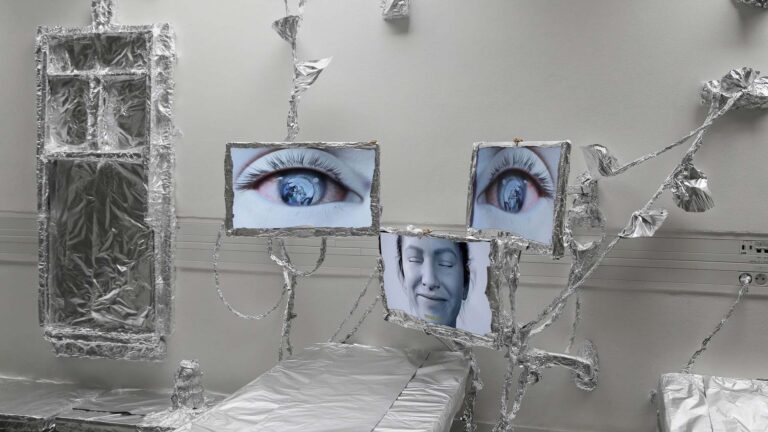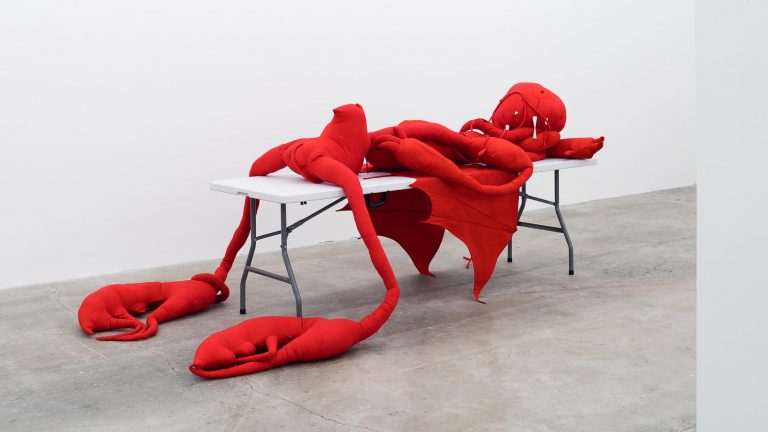Artist: Jakub Choma
Exhibition title: We Are Smelly, Atomised, Chemical, Vanilla
Curated by: Eva Slabá
Venue: Smečky Gallery, Prague, The Czech Republic
Date: May 29, 2024 – July 27, 2024
Photography: Jan Kolský / all images copyright and courtesy of the artist and Smečky Gallery, Prague
Jakub Choma’s (*1995) largest exhibition project to date is composed of the artist’s previous projects, which he transforms for the space of this gallery through his typical work in the medium of assemblage. Although at first glance this exhibition can be seen as a retrospective, a closer examination reveals that the visual poetics through which Choma explores the frictional surfaces of societal topics is a live, almost sculptural work with a medium on the border of installation within a specific environment. A sophisticated system, characterised by precise procedures and elaborate processing of materials, is built on the reworking of information from the artist’s immediate surroundings – we can think of it as a fragmented whole using the flexible principle of the structure of a given medium. Choma himself refers to this assemblage as a resilient assemblage, which is not definitively terminated, on the contrary, it is connected only temporarily. This, in his conception, reflects a view of the human body itself, whose lived experience is shaped by conditions coming from different spheres of influence: biomedical, social, geopolitical or (post)digital.
The shift in the conceptualization of the body, influenced by the growing achievements of the biosciences, visualizes even the smallest parts (often at the molecular level) as seemingly disconnected from the body as a whole. In the context of the interconnection of technology and biology and the commodification of human vitality, we can therefore speculate about the emergence of new, so-called somatic assemblages. These use the system of the totality of the body, but apply it to its parts, creating new wholes. The exhibition thus presents an alternative type of perspective on how it is possible to look inside the “bodily machine”, a choreographed movement of electric currents that constantly pulsates and conditions every single decision and every single thought. It is a neuronal fantasy of how to understand the link between the human and the (in)organic; a scanning portrait of what it is to move in the present between technology and virtuality, materiality and physicality – to be “Smelly, Atomised, Chemical, Vanilla”.
PART 1 – LIFEPATH CUSTOMIZATION
The notion of the atomized body inherently contains questions about the way in which the body and its parts are commoditized today, and how the body is described and visualized with this in mind. Phenomena of this type not only affect people’s everyday lifestyles and ways of thinking and acting, but also the norms and laws that govern society. The exhibition project, not entirely by chance, but rather with regard to the genesis of Choma’s work, begins with his earliest projects, but (as mentioned above) these have undergone significant modifications. The very first cork wall object, Continual Interruption (2018/2019), characterizes the artist’s thinking as much as his handling of the material in the context of the concept of the hanging painting. The use of purely physical resources, such as industrial materials (metal sheets, scrap metal, rubble, pigment, chains, springs or matrices, and Choma’s characteristic cork), is expanded in meaning through the use of digital printing and the lasering of single words or fragments of sentences, through which the artist achieves the desired affinities and the emergence of new assemblies. The diagonally positioned work Same Person, Different Me (2018), reminiscent of a dressing table in a performer’s dressing room, refers to the experience of the digital (and possibly gaming) environment – the customisation of character, the creation of virtual selves, the process of transformation and the manipulation of the physical body. The self-portrait Untitled_5 (from the series Island of Uncertainty, 2023) also corresponds to this. From the hair baldness caused by alopecia grows a cold metal jewel or perhaps a custom-made high-tech accessory. The subversion of binary frames, including the dichotomy of the virtual and analogue worlds, is then shown in the extension of a project that was originally intended for the online environment. A four-part performative video shot from a first-person perspective, Beta Ground (Delirium Obstacle, 2019) takes place in a barn in the Slovak countryside over the course of a day, following the model of an audiovisual diary. The protagonist explores the ruins, looking around for materials and tools, while it is unclear what of himself is still organic and what, in turn, is already technological.
PART 2 – „UNDER PRESSURE ALL SCREENS CRACK“
If the entrance to the exhibition is adorned with garlands as a critical reminder of unfulfilled ideas of techno-optimism, then all the above-mentioned works are united by one thing – an attempt to express the feeling of exhaustion from the promised utopian future, which bears more the features of dystopia. The constant scrutiny of one’s own economy of attention, the simplification of ideas and processes leading not only to their emptying, but also to the emptiness of language and the daily encounter with the so-called “hustle (grind) culture” are the common denominator of the current experience. The title of the reddit thread, “Shouldn’t NPCs Have Their Own Rights?” playfully alludes to exactly this fact – the quest to liberate the Dummy_1 (Overthinker, 2017-2024), which normally serves only as a training dummy to develop the main character’s skills in the online fantasy game World of Warcraft (WoW). The voiceover that accompanies the dummy, together with the duplicity of the self and the Lacanian first sighting of himself in the reflection of the mirror, thematises the schizophrenic scatteredness of his personality between spaces. In the peripheral horizon, then, dummy has nothing but a picturesque scene of the expanding sky, with the deviation that the clouds are obscured by eye floaters – evidence of his self-aware spiritual independence. The moment of contemplation of one’s own fate and the subsequent attempt to collect oneself is echoed in a parallel installation consisting of a motorized InEx (2024) shaft. The latter performs an eerie breathing exercise for overall calming and “for a better day and future” with the help of a plastic bag. The scene is rounded off by the Untitled (Essentials, 2024) shelf system unit and the Standing Still (2021-2024) tank, which feature fossils made of cork. Almost from the beginning of Choma’s practice, cork has been an elemental unit with which he works on many levels of his “worldbuilding.” A cork grain can be compared to something as basic as an atom or, perhaps, a digital pixel, a skin pore, and a cell, the structural and functional unit of the bodies of living organisms. This idea is, after all, developed in many places throughout the exhibition – sometimes the cork slabs appear as fossils or relics (tokens) in airtight capsules, valuable items of inventory, sometimes as fist wedges – extensions (prostheses) of a human hand holding a smartphone.
PART 3 – CHEMICAL AND VANILLA
The relation of physical materials to virtual experience and the disorientation of the body in the map of the city is ultimately referenced by the first work in this last section of the exhibition, Distractor (2021/2024). The illuminated distractor figures as a “respawn place” (usually a place of rebirth after virtual death in a game environment) or a landmark in a confusing urban structure. The uncertainty is exacerbated by the wall object Security Is A Quick Sand (2018-2024), playing with the comparison of “data existence” in an online interface to the television pop culture phenomenon of the noughties – quicksand. The world built by Choma is, in short, a world on the verge of collapse in the sense that there is a constant threat of immanent annihilation of the self – for by combining the original particles, they disappear and particles of another, new type are created. Although technology allows us to perceive more, as it widens the angle of vision, it also mediates perception, making it less direct for us. In science fiction, spectacular visuality is used to enthrall the viewer and reassure them that subjectivity still has existential validity, despite being a mere effect resulting from the operation of the technical apparatus. This is well demonstrated in the assemblage Teeth (2023). The photographically depicted floss in the oral cavity is replaced by aluminium wires and mains cables, from which a current gushes into space with the help of an illusory print. The meta-referencing of this representation hints at associations such as electrical flow, the transfer of chemical neurotransmitters, saliva flow or the flow of life-giving water. The autobiographical experience behind this assemblage literally overflows, flowing under the feet of the visitor standing on the raised pontoon, detoxifying, floating past the barrels collecting (addictive) game tokens up into the shafts through which it enters the previous space. A constructed mining image loosely reminiscent of candy stores in the heart of the capital thus circulates back to the oral cavity and the enzymes used to break them down. A central place, based on the artist’s thesis, is then occupied by the “altar” of Reagent Bank (2023), a repository of accumulated raw materials and objects, the result of a day’s (or night’s) hyper-productivity and a consideration of their economic utility. The graphic grid, appropriated again from the WoW game world, is also followed by a colourful stained glass window in the form of a “health bar” (indicators of the values of various WoW life functions) in the doorway leading to the gallery courtyard. The latter, as well as the use of the texture of the paving stones and jute sacks, once again reminds us of the border between the lived and the artificially constructed reality. The exhibition symbolically closes with the projection Stucked (Metallic Aftertaste, 2023) above the stairs leading to the basement (and blind spot) of the gallery. The visitor’s body here at some point mimics the digital semi-transparent body trapped in the loop of the video and indeed the burden of the game’s economy. A nostalgic-sounding soundtrack composed of lo-fi beats, a recording of a call, and the sound of coins disappearing into a pay phone tray, along with a joker displayed in the basement in the form of Cold Cord (2023), reminds us that the body may be dying, but the phantom vanilla smell and data remain.














































